Learning & Development: Under-threes - Shared experience
Helen Sutherland, Jan Styman
Monday, November 4, 2013
New materials offer guidance for those working with diverse and disadvantaged toddlers. Helen Sutherland and Jan Styman explain.

A raft of teaching materials and resources promoting effective practice in working with diverse and disadvantaged toddlers and their families has been developed by early years specialists across eight European countries and is now available online.
The materials, which aim to promote reflective practice, have been developed as part of the TODDLER Project. TODDLER stands for 'Towards Opportunities for Disadvantaged and Diverse Learners on the Early Childhood Road' and the initiative was set up in response to the 2009 Eurydice Report, which highlighted the continuing inequity in education for children from diverse and disadvantaged backgrounds.
Now available at www.toddlerineurope.eu, the resources include a section on Toddlers in a European Context and materials on four aspects of provision identified as essential in meeting the needs of disadvantaged toddlers and giving them a fair chance of lifelong learning. They are:
- Supporting Well-being
- Language Development in Multicultural Settings
- Enhancing Parental Involvement, and
- The EYP as a Reflective Practitioner.
Together, the materials mean practitioners across Europe now have the opportunity to share and reflect on approaches and practices across key aspects of early years provision. As well as providing a valuable resource for teachers and practitioners to explore and develop their practice, the resources will support the continuous professional development of those working with toddlers. The materials will be particularly valuable to those caring for two-year-olds on the funded programme.
RESOURCES
The project brought together teacher trainers from nine universities across Europe to share, examine and develop different approaches to supporting toddlers' learning. Responsibility for developing the materials was divided between the partners according to their strengths and experience. However, all the participants contributed to the resources, which combine the necessary theoretical support with case studies.
Language Development in Multicultural Settings includes an observational tool and manual to facilitate the collection of data relating to how languages are used by children and staff in a setting and so raise intercultural awareness. The manual also provides strategies for the promotion of language within the setting.
Enhancing Parental Involvement includes a DVD focusing on teacher-parent relationships. The teaching guidelines have been developed to support practitioners in reflecting on the case studies, showing effective ways of involving parents and overcoming the challenges of engaging with families. The DVD is available on YouTube at http://bit.ly/1aVuZzu.
The EYP as a Reflective Practitioner includes a guidance manual on how to undertake reflective sessions with student teachers and teachers to support links from theory to practice.
SUPPORTING WELL-BEING
Kingston University has been responsible for the design and content of the teaching materials to promote well-being. The materials are designed to be flexible and to enable students, practitioners and teachers to:
- examine their own country's definition of well-being and how this is demonstrated in practice
- compare and contrast the examples provided within the materials to identify effective and good practice
- review relevant literature, including curriculum documents, national research and the recommended reading
- observe how different settings promote well-being and reflect on their own practice to enhance the well-being of the toddlers in their care.
Each country provided a definition of well-being, and from this keywords were identified and a 'wordle' created (see below). The teaching materials provide a definition of well-being, theoretical underpinning, relevant literature and research, and legislation supporting the concept of well-being from each country, as well as case studies that provide examples of good practice.
The case studies comprise information on the type of setting/status, demographics, how well-being is identified, measured and monitored, and the strategies used to promote it.
They are presented through Reflective Storyboards, which provide a visual representation of practice for each identified setting, and cover activities throughout a typical day. The storyboards (see right for an example) include:
- transitions and settling-in of toddlers into early years settings
- a programme with or for parents that helps them to support their child's well-being
- an activity, experience or opportunity for exploration that promotes the toddler's well-being
- how the environment supports and enables well-being through activities such as the daily routine, resources or organisation of the environment
- an activity that supports social well-being, such as singing, circle time or mealtime.
Knowledge gained through these examples of good practice will enable early years practitioners, teachers and students to reflect on the complexity of well-being across Europe and explore how they can develop their practice to meet the needs of the children in their care.
Helen Sutherland and Jan Styman are senior lecturers in early years education at Kingston University, London
REFERENCES
- Child Poverty in Perspective: an overview of child well-being in rich countries, The United Nations Children's Fund (UNICEF)
- Early Childhood Education and Care in Europe: tackling social and cultural inequalities, EURYDICE, 2009, European Commission. The Eurydice Network provides information on and analyses of European education systems and policies.
- Starting Strong: early childhood education and care, Organisation for Economic Co-operation and Development (OECD), 2001
- The Effective Provision of Pre-school Education (EPPE) Project: findings from pre-school to the end of Key Stage 1, by K Sylva, E Melhuish, P Sammons, I Siraj-Blatchford and B Taggart, 2004, available at www.ioe.ac.uk
- 'The impact of high-quality ECEC on the development of young children: review of the literature'
in: EACEA Early Childhood Education and Care in Europe: tackling social and cultural inequalities, by P Leseman, 2009, EU Commission
- Well-being from Birth by R Roberts (2010), Sage
PARTICIPANTS
The universities involved in the TODDLER project are:
- University of Stavanger, Norway
- University College South Denmark, Denmark
- West University of Timisoara, Romania
- University College Arteveldehogeschool, Belgium
- Kingston University, London
- University of Education, Schwabisch Gmund, Germany
- Instituto Politecnico de Santarem, Portugal
- Universitat Ramon Llull, Spain
- Haute Ecole Libre Mosane, Belgium
CHALLENGING OUTDOOR PLAY: A STORYBOARD
This example of a well-being storyboard is from a Norwegian municipal daycare kindergarten, for 120 children aged one to five.
Context of the strategy
The playground is carefully designed to offer social play, sensory experiences, motor challenges and discovery. Toddlers enjoy moving their bodies freely and in many different ways: walking, running back and forth, sliding, balancing, climbing, crawling or walking up and down stairs. The adults stay close to provide emotional security and to encourage play, humour, discovery and astonishment. They act as role models for play. The environment offers a lot of contrasts during the shifting seasons and staff use these changes to offer 'wow' moments and 'aha' experiences. Just think of the changing qualities of the sand: dry or wet, falling apart or sticking together, warm and easy to shape or even frozen and hard.
Points for reflection
Identify how the well-being of toddlers is being met through the environment and the practitioners.
Identify aspects of your own provision and how these could be developed to enhance the well-being of the toddlers.
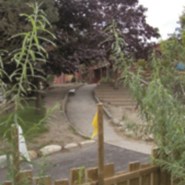
Walking up a slope is different from running down.
The small gates provide shelter for play.
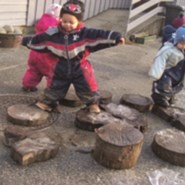
Loose logs to walk on may challenge balance. Toddlers imitate each other's movement. The logs may also be pushed and moved by the children.
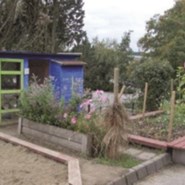
Flowers and potatoes grow in the small beds during the summer.
Even worms can be found. The potato harvesting is celebrated with a feast.
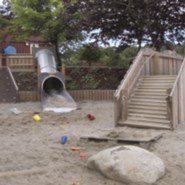
Large sand areas offer safe play with slides and other climbing equipment. Sand is often put in buckets and mixed with water. The buckets are carried around and poured.
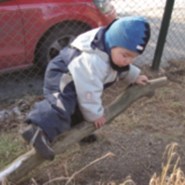
It is not easy to climb over such branches, but after several attempts toddlers will manage.
A new discovery: rainwater from the puddle disappears in to the drain. You cannot get it back.
Sometimes, toddlers need adults to encourage them to use the equipment.
The staff do not lift up toddlers, due to safety reasons.
The moss offers a sensory experience of softness. The stones are smooth. In summer, flowers grow in the pots.
Small bushes are cut properly for hiding and peek-a-boo, a well known and popular game. The climax and most important thing is to be found by another person.




